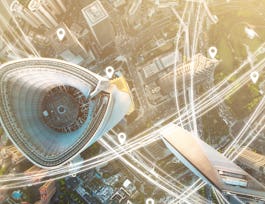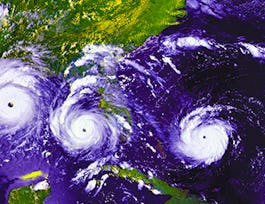How can we prevent satellites from colliding? How can satellites be protected from meteorite impacts? How important are satellites in today’s age? How safe are astronauts on the ISS and why does their research help mankind in general? What happens with space debris distributed in orbit?



(18 reviews)
Details to know

Add to your LinkedIn profile
24 assignments
See how employees at top companies are mastering in-demand skills


Earn a career certificate
Add this credential to your LinkedIn profile, resume, or CV
Share it on social media and in your performance review

There are 9 modules in this course
Welcome to our course on Space Safety. The introduction by former astronaut Thomas Reiter will provide the kick-off to your studies. Enjoy the course!
What's included
1 video1 reading
Space safety addresses the protection of human infrastructure in space and on the ground from hazards originating in space. This lecture describes the three domains of space safety as a general introduction to the lecture series. It explains the origin and impact of space weather events and the fundamentals of planetary protection. It then concentrates on the third domain – man-made space debris. Ever since the start of the space age on 4 October 1957, more space debris has accumulated in orbit than operational satellites. Space debris poses a problem for the near-Earth environment on a global scale. As all space-faring nations have contributed to the situation, all these countries will need to share the responsibility for its resolution. The lecture will touch on the main subjects of space: space debris environment, space debris mitigation, legal aspects, measurement methods, re-entry to Earth, protection and necessary steps to remedy the current situation.
What's included
6 videos2 readings1 assignment
This lecture’s objective is to provide students with a basic knowledge of the concept of space weather, how it is produced by our Sun, its most critical characteristics and how it can impact our infrastructure. The lecture gives an introduction to solar and heliospheric physics and presents eruptive events in the Sun producing the most severe space weather conditions. Interaction of the solar electromagnetic radiation and solar wind with the earth’s magnetosphere and atmosphere is described to provide a basic understanding of why space weather, for example, changes the radiation environment in space, impacts radio signal propagation in satellite navigation and produces the beautiful aurora. The final part of the lecture explains how we monitor space environment and space weather and how the data collected by space weather instruments is used to provide space weather services for the protection of our infrastructure.
What's included
7 videos2 readings4 assignments
Decades of launching spacecraft and upper stages have created an environment which requires understanding and counter measures. Space ebris is generated by break-ups, collisions, solid rocket motor firings, reactor coolant releases, paint flakes and ejecta. Models to describe the environment are calibrated with measurements from power radar stations, optical telescopes and in-situ data. Space surveillance means provide a catalogue of orbital elements and other information of objects in space. These catalogues facilitate collision avoidance, re-entry predictions, detecting fragmentation events, supporting operations and verification of compliance with regulations. Space debris mitigation is intended to reduce the increase in space debris in order to ensure space sustainability and minimise risk for humans, the Earth’s environment and assets associated with re-entry of space systems.
What's included
6 videos2 readings6 assignments
This lecture describes the techniques for avoiding collisions between active spacecraft and other objects orbiting the Earth. Knowledge of trajectories of objects involved in a potential collision (called a close approach or conjunction) is key. Since such parameters are never completely reliable, typically a collision cannot be predicted (or ruled out) with certainty. Instead, collision probabilities are used as basis for decisions on avoidance actions. The first part of the lecture is thus dedicated to key aspects of conjunction geometry and the mathematical approach to obtain collision probability. The second part deals with avoidance strategies and presents an introduction to the actual operational process for collision avoidance, showing typical activities, schedules and tools as well as some examples and statistics on collision avoidance operations at ESA’s spacecraft control centre ESOC. An outlook on future challenges and approaches completes the presentation.
What's included
5 videos2 readings1 assignment
This lecture’s objective is to provide students with a basic knowledge of the concept of how to deal with potential asteroid impacts.
What's included
5 videos1 reading5 assignments
This lecture is about the German SSA Centre (GSSAC), looking at nearly the first 10 years of the civilian-military GSSAC from 2011 up until today and presenting its set-up as a civilian-military centre. The various interests in space are outlined by sketching out the civilian and the military perspectives on the use of space. After the introduction, the national sensors available to GSSAC are discussed in general, showing in particular the accessible radar systems as one of the best in the world. These sensors form one part the foundation on which the GSSAC performs its mission to provide high quality services in the field of SSA to national and international users. The range of services covers all parts of SSA, including space weather and near-Earth objects. The strong involvement of the GSSAC at an international level – with Germany being often one of the first partners, if not the very first, to cooperate with – underlines the international appreciation of the GSSAC’s work done at national level.
What's included
4 videos1 reading4 assignments
Cyber security deals with all aspects of security in information and communication technology (ICT), such as all technologies connected to the internet and comparable networks, and includes communication, applications, processes and processed information based on ICT. Public security is one of the responsibilities of governments, i.e. safeguarding their citizens and other persons in their territory, organisations and institutions against threats to their general welfare and to their communities’ prosperity. The first part of this online course deals with cybersecurity governance in Europe and provides an overview of the main institutions dealing with cybersecurity, such as the EU Directorate-General Connect, the agencies ENISA and BSI and their tasks. The second part contains examples of European cybersecurity legislation and the underlying process, detailing the cybersecurity directive on network and information security (NIS directive), the regulation on electronic identification and trust services for electronic transactions (eIDAS), the General Data Protection Regulation (GDPR) and their implementation. The third part gives an overview of relevant ICT sectors and players, including the topics venture capital and acquisitions in the cybersecurity business. Current discussions on digital sovereignty and examples such as the 5G technology round up this course, concluding with an outlook on the Digital Europe Programme.
What's included
3 videos2 readings3 assignments
In this course module, you receive an adequate overview of the medical space research from experts at LMU University Hospital of Munich. Professor Choukér together with his colleagues Professor zu Eulenburg, Dr Wöhrle and Dr Moser present how research in space is connected with research results on Earth, how stress and immune system research helps astronauts and patients here on Earth and also what a space flight would do to our brain. They explain examplewise how the analyzing of astronauts’ blood samples helps patients in intensive care units and point out how studies performed in space can be transferred to humans on Earth. Also the effect on human bodies when staying in space for a longer time period plays an important role in this course section, especially the transformation of cells when being exposed to the absence of gravitiy.
What's included
6 videos1 reading
Instructors


Offered by
Why people choose Coursera for their career




Learner reviews
18 reviews
- 5 stars
72.22%
- 4 stars
16.66%
- 3 stars
5.55%
- 2 stars
0%
- 1 star
5.55%
Showing 3 of 18
Reviewed on Aug 20, 2024
I found this course to be very interesting and believe it would be valuable for those interested in Space Safety.
Recommended if you're interested in Physical Science and Engineering
University of Pittsburgh

Technical University of Munich (TUM)

University of Colorado System

Open new doors with Coursera Plus
Unlimited access to 10,000+ world-class courses, hands-on projects, and job-ready certificate programs - all included in your subscription
Advance your career with an online degree
Earn a degree from world-class universities - 100% online
Join over 3,400 global companies that choose Coursera for Business
Upskill your employees to excel in the digital economy




